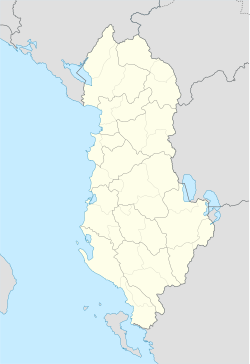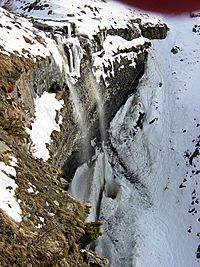Kolonjë facts for kids
Quick facts for kids
Kolonjë
|
||
|---|---|---|

Ersekë, the main settlement of Kolonjë
|
||
|
||
| Country | ||
| County | Korçë | |
| Area | ||
| • Municipality | 865 km2 (334 sq mi) | |
| Population
(2011)
|
||
| • Municipality | 11,070 | |
| • Municipality density | 12.798/km2 (33.15/sq mi) | |
| Demonym(s) | Kolonjar/e | |
| Time zone | UTC+1 (CET) | |
| • Summer (DST) | UTC+2 (CEST) | |
| Postal Code |
7401
|
|
| Area Code | (0)812 | |
Kolonjë is a municipality in Korçë County, southeastern Albania. It was created in 2015 by the merger of the former municipalities Barmash, Çlirim, Ersekë, Leskovik, Mollas, Novoselë, Qendër Ersekë and Qendër Leskovik. The seat of the municipality is the town Ersekë. The total population is 11,070 (2011 census), in a total area of 865 km2 (334 sq mi). It is an ethnographic region.
The area of the municipality is coextensive with the former Kolonjë District, one of the 36 districts of Albania, which were dissolved in July 2000 and replaced by 12 counties.
Location
Kolonjë is located in south-east Albania and its capital is Ersekë. Other towns in this district include Leskovik to the south. It is bounded by Korçë to the north and Greece to the east, including the regional units of Kastoria and Ioannina. The town of Ersekë is located at the foot of mount Gramos, Albania's fourth-highest mountain with a peak at 2,525 m above sea level.
History
During the Middle Ages a region under the name Koloneia is located in the mountain region south of Korçë (southeast Albania) and north of Konitsa and Kastoria (northwestern Greece) at the west slopes of Grammos mountain range. A Byzantine military garrison under the same name was built west of Grammos.
According to the account of John Skylitzes, in c. 1018, after the Byzantine conquest of Bulgaria, emperor Basil II created new themes at Koloneia, Dryinopolis, and Dyrrhachium, and settled former Byzantine prisoners of war to secure the Byzantine positions in Epirus against future enemy attacks from central and western Macedonia. At 1040s the theme of Koloneia was incorporated to the Duchy of Dyrrachion. After the Sack of Constantinople at 1204 and the following partition of the Byzantine Empire Koloneia was granted to the Republic of Venice. However, Koloneia came under the control of the Despotate of Epirus and formed one of the themes of the Despotate. Following the Battle of Pelagonia in 1259 Koloneia was ceded to the Empire of Nicaea.
In a text by Emperor John VI Kantakouzenos (r. 1347-1354) whose 'History' covers the years 1320-1356, there is mention of local Albanians; “While the emperor was spending about eight days in Achrida (Ohrid), the Albanian nomads living in the region of Deabolis (Devoll) appeared before him, as well as those from Koloneia (Kolonja) and those from the vicinity of Ohrid.” This meeting was estimated to have taken place at around February 1328.
One source says that one of the two main waves of Albanian movements coming from the north entered Kolonjë in the 14th century, with the wave also affecting the neighboring Dangëllia region. The name Kolonja is related to the Roman period of the area.
Villages, communities and settlements
- Barmash
- Bezhan
- Blush
- Borovë
- Butkë
- Çlirim
- Ersekë
- Gjonc
- Gërmenj
- Gostivisht
- Helmës
- Kabash
- Kagjinas
- Kaltanj
- Kamnik
- Kodras
- Kozel
- Kreshovë
- Kurtez
- Lashovë
- Lëngëz
- Lënckë
- Leshnjë
- Leskovik
- Luaras
- Mesicke
- Milec
- Mollas
- Novoselë
- Orgockë
- Piskal
- Podë
- Postenan
- Prodan
- Psarr i Zi
- Qafzes
- Qesarakë
- Qinam Radovickë
- Qinam
- Qytezë
- Radimisht
- Radanj
- Rehovë
- Selenicë e Pishës
- Shalës
- Shtikë
- Shën Mërtir
- Starje
- Taç
- Vodicë
- Vrepckë
Notable people
- Sali Njazi, 1st Dedebaba of the Bektashi Order
Sources
- Soustal, Peter; Koder, Johannes (1981) (in German). Tabula Imperii Byzantini, Band 3: Nikopolis und Kephallēnia. Vienna: Verlag der Österreichischen Akademie der Wissenschaften. ISBN 978-3-7001-0399-8. https://books.google.com/books?id=6fx-QgAACAAJ.
See also
 In Spanish: Kolonjë para niños
In Spanish: Kolonjë para niños




